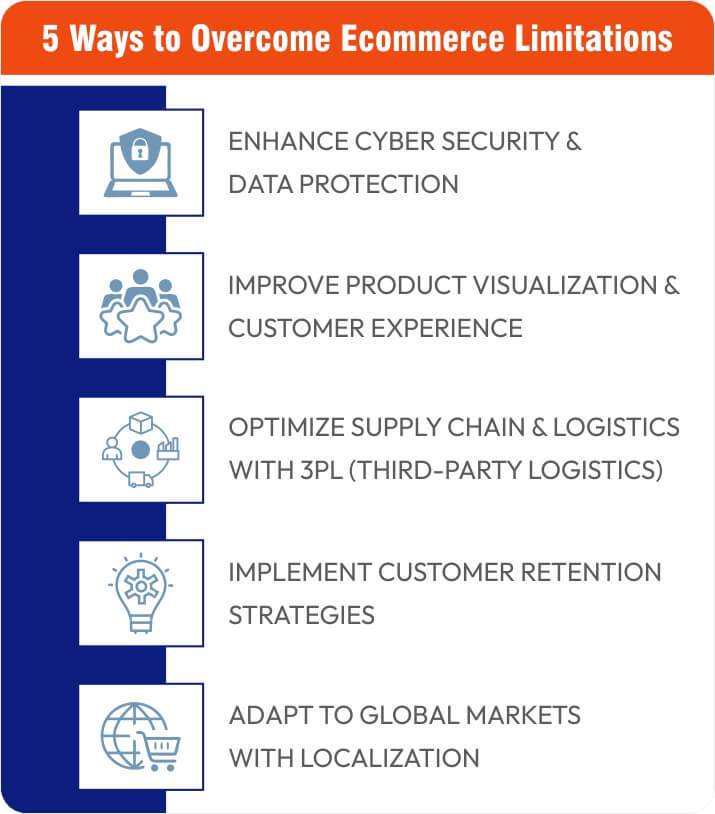- GF/ SF - Tejas, Opp Hotel Prasadalay, Shukrawar Peth, Pune - 411002
- +91 90 2132 2132
A Guide for the Limitations of Ecommerce Business

Ecommerce has changed the game for businesses. It has almost no limits to reaching customers worldwide. But let's be honest; it's not that easy all the time. Problems from shipping delays to extreme competition make it quite challenging to work online. Whether you're a new entrepreneur or a seasoned seller, understanding these limitations in building a stronger and more resilient business.
Ecommerce is the buying and selling of products and services online through websites, marketplaces, and social networks. Rapid growth in this field comes from technological progress, the shift in consumer behavior, and the high-end benefits of conducting transactions online.
The COVID-19 pandemic further accelerated its expansion and got a real boost into multiple businesses. Of course, it was due to e-business, but there are other aspects, including logistics and communication, along with such problems as competition and trust from consumers towards this platform. Understanding these limitations is crucial for businesses to develop strategies for long-term success.
Let us look into the realities of the ecommerce space and how to overcome them effectively.
Top 10 Limitations of Ecommerce Business
-
Data Security Challenges
People are hesitant to share their personal and financial information via the Internet. Customers need reassurance that their data is safe in a world that struggles with threats like hacking and fraud. Trust is not automatic with high-level encryption and security measures.
Furthermore, some websites might collect information without any proper consent by raising a larger issue of privacy security. To gain consumer confidence, ecommerce businesses need safe payments, compliance with data protection laws, and absolute transparency with how they handle user data. -
Virtual Shopping Limitations
The inability to see, touch, or try a product before buying leads to mistrust and uncertainty. The customers may worry about the quality of the product, whether the product is being described accurately, or whether the product will suit their purpose and hence may hesitate.
They are deprived of the in-store experience where they test functionality, feel the materials, or check true colors. Hence, detailed product descriptions, high-quality images, videos, and customer reviews are essential in forming purchase decisions for customers. -
Cybersecurity Challenges
Hacking, data breaches, fraud - these are continual risks to e-commerce. Cybercriminals target typical consumer sensitive data like payment information, opening doors to possible identity theft, resulting in loss of finances. Since security measures are put in place, there would still be new threats coming in and would require a huge capital set aside for strong encryption, secure payment gateways, and regular updates of the system against malware.
One breach would not only cost finances but also trust from customers which is hard to gain again. Thus, proactive measures must be employed by an e-commerce company, educating the customers about safe online shopping, as well as an adaptive course of action towards the continually evolving face of cyber threats. -
Regulatory & Tax Compliance
Ecommerce is not all about generating sales; it is also about adhering to several rules and regulations. Different tax law, import duty, and standard regulations can sometimes get quite complicated in each region. If businesses fail to comply with these laws, they can be fined, sued, or even shut down.
In addition to that, tax policies and rates being constantly changing make it so difficult to keep things up-to-date. The up-to-date knowledge, the use of automated tax tools, and the consultation of experts are not just good ideas; they are essentials for long-term survival. -
High Operational & Technological Costs
Being engaged in ecommerce is more than just having a site built and being paid; doing this requires plenty of investment, starting from user-friendly developments and ending in safe payment and delivery costs, which points out significant costs.
Besides that, businesses need to spend on cyber security, software updates, and server maintenance to keep everything in good running order. And let's not forget-technology is always changing; therefore, the need for constant upgrading to stay ahead of the competition. -
Customer Loyalty Struggles
Gaining a new customer is hard, but keeping that customer is even more challenging. Online, if customers find better prices, faster shipping, or more personalized experiences, they can easily jump over to competitors.
Therefore, selling isn't all; good customer service, loyalty programs, and personalized marketing are ways to begin building lasting relationships. In the end, repeat customers are what will truly give a business longevity; keeping them happy should be a top priority at all times. -
Supply Chain Struggles
Smooth supply chains are important when it comes to e-commerce, but of course, nothing ever goes as planned. Global calamities, shipping delays, and even inclement weather can slow deliveries and leave stores barren.
And when orders longer than usual become the norm for those customers, they get frustrated, take the first step toward loss of trust in the business. Hence, backup suppliers, logistics flexibility, and real-time tracking are not only an option, but a necessity that smoothens everything. -
Managing Returns & Refunds
Returns are a part and parcel of ecommerce, but if not dealt with properly, they can really chew into profits and frustrate customers. High return rates are costly because they demand shipping costs, restocking, and the processing of refunds. Most importantly, they put the loyalty of customers at risk.
Clear return policy, hassle-free procedure, and quality check can help in minimizing these cases. Eventually, such a process would make a one-time buyer a loyal customer. -
Hidden Marketplace Costs
Selling on ecommerce platforms seems convenient, but the fees can quickly add up. There are listing fees and transaction fees; out of many, there are commissions and payment processing fees.
For small businesses, it can be difficult to stay competitive while covering these expenses. Hence, sellers need to do a cost-benefit analysis of platforms, plan pricing as best as they can, and find ways to minimize fees to maximize profits. -
Global Selling Challenges
It sounds exciting to sell to the world, but it can get very tricky with cultural differences and the language barrier. What might seem appealing in one country does not cross well with customers in another, and a simple error in translation may confuse buyers, even to the point of offense.
Then, payment preferences, shopping habits, and customer expectations all vary increasing the challenge of a market. That’s why businesses need to localize their content, understand regional shopping trends, and offer multilingual support to keep things running smoothly.
5 Ways to Overcome Ecommerce Limitations

-
Enhance Cybersecurity & Data Protection
Encryption of high strength, appropriate payment gateways, and performing security audits regularly will do wonders. One should be well versed in data protection laws (i.e., GDPR, CCPA) and maintain transparency with clients on how their data is collected to create more trust.
When customers trust your environment with respect to secure transactions and privacy policies, it gives them less reason to hesitate when sharing personal information. -
Improve Product Visualization & Customer Experience
High-resolution pictures, 360-degree product views, AR/VR technology, along with detailed descriptions can narrow the gap between virtual shopping with high-quality images. Customer reviews, video demonstrations, and try before-you-buy options (where applicable) will help customers to make informed decisions.
-
Optimize Supply Chain & Logistics with 3PL (Third-Party Logistics)
Collaborating with a reliable third-party logistics (3PL) company, like Velocity Express, will certainly enhance your ecommerce business order fulfillment, warehousing, and shipping functions. Accordingly, the fulfillment time will be lower, costs will be reduced, and deliveries will be set faster.
Shifting to advances could result in the establishment of real-time tracking and integration of delivery on the same day, as well as flexible logistics options for your business that prefers to increase the value for its steady profit-driven customers. -
Implement Customer Retention Strategies
Build loyalty through personalized shopping experiences, exclusive discounts, and membership programs. AI recommendations, live chat support, and personalized email marketing will serve as tools to engage customers and encourage repeat purchase behavior.
-
Adapt to Global Markets with Localization
Globalization means localization - providing multi-language support, region-specific payment options, and market-appropriate promotional content. Your business must further abide by local regulations and tax laws. Customizing the buying experience is the way for companies to better their conversion rate, increase customer confidence, and create a viable global brand.
Final Thoughts
An ocean of opportunities awaits in the form of e-commerce, but it comes with challenges such as cybersecurity risks, supply chain disruption, and customer retention. It's important to know these limitations of an ecommerce business for the long-term success of the organization. Strong security measures coupled with well-improved customer experience, greater leverage of the 3PL services such as Velocity Express. Localizing for global markets can prevent businesses from the effects of such eventualities.
Adapting to these challenges with strategic solutions ensures sustainable growth, better customer satisfaction, and a thriving ecommerce business in an ever-evolving digital landscape.
